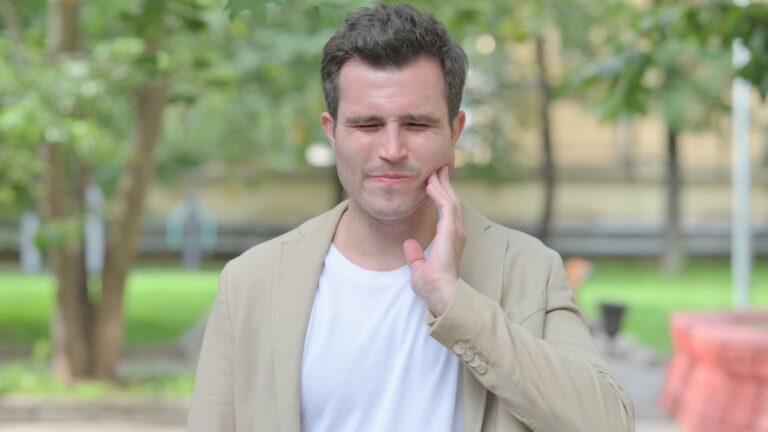Swelling after wisdom teeth removal is an expected part of the healing process. However, in some cases swelling can be excessive or persist longer than is typical. Prolonged swelling can be frustrating and also indicates complications may be developing. This article explores the possible reasons why swelling may not subside as quickly as anticipated after wisdom tooth extraction.
Normal swelling timeline after wisdom teeth removal
After any tooth extraction, the body mounts an inflammatory response which causes swelling in the tissues surrounding the wound. This is a normal protective reaction that helps fight bacteria, remove damaged tissue, and begin the healing cascade.
With wisdom teeth removals, the surgical trauma to the jaw bone and gums triggers the release of chemical messengers called prostaglandins which dilate nearby blood vessels. This leads to an influx of fluid, antibodies and white blood cells into the area. As a result, swelling, inflammation and pain occur and generally peak around 2-3 days after surgery.
For uncomplicated wisdom tooth extractions, the normal swelling timeline is:
- Days 1-3 – Significant swelling and inflammation develops and peaks at 48-72 hours post-op. Swelling is often worst on Day 3.
- Days 4-7 – Swelling gradually begins decreasing but may descend into the neck and under the chin region. Use of cold compresses can help manage swelling.
- Days 7-14 – Ongoing steady reduction in swelling, stiffness, and discomfort. There may still be some visible swelling, but the worst is over.
- Weeks 2-4 – Swelling fully resolves in most patients during this time frame. Temporary numbness also diminishes. Residual swelling or bruising may still be evident, especially with extensive extractions.
For complex wisdom tooth extractions – such as impacted teeth or all 4 extractions in a single visit – the swelling timeline is often prolonged by 1-2 weeks. However, if improving swelling suddenly worsens or other symptoms develop, contact your oral surgeon promptly.
Why might swelling persist longer than expected?
For some individuals, swelling lingers longer than the typical 1-2 weeks postoperatively. Excessive or prolonged swelling beyond this timeframe may be due to:
Infection
One of the most common causes of delayed healing is infection setting in. Signs may include:
- Swelling that worsens or begins after day 3 when it should be improving
- Increased redness and pain around the extraction site
- Pus discharge or foul odor
- Fever higher than 101F
Infections require prescription antibiotic treatment from an oral surgeon to clear up.
Dry socket (Alveolar osteitis)
Dry socket develops when the protective blood clot at the surgery site fails to form properly or gets dislodged too early. With dry socket:
- Throbbing, radiating pain typically begins a few days after extraction and persists
- Grayish coating may be visible in the empty socket
- Foul breath is common
Dry socket delays healing and causes ongoing pain and swelling. See an oral surgeon promptly if you suspect this complication.
Food trapped in the socket
Trying to eat too soon after wisdom tooth removal can allow food particles to get packed into the socket. This leads to added irritation, infection risk, swelling and foul breath. Stick to a liquid diet for at least 24 hours after surgery.
Reaction to medications
Some people may experience exacerbated swelling or other reactions from medications like antibiotics or oral contraceptives. Let your oral surgeon know if you have any drug allergies or sensitivities beforehand.
Bony impactions
Partially impacted wisdom teeth that are embedded in the jaw bone are more complicated to extract fully. This often causes more surgical trauma and swelling afterwards which takes longer to subside.
Multiple extractions
Getting more than 1 wisdom tooth out in a single procedure almost always leads to increased swelling and a longer recovery. This is especially true if removal of all 4 wisdom teeth is done together.
Tips to help reduce wisdom teeth swelling

Although swelling is a normal part of healing after extractions, there are ways to help minimize swelling and speed resolution:
- Apply cold compresses to the cheeks for 10-20 minutes several times a day for the first 48 hours after surgery. Cold constricts blood vessels which limits early swelling and inflammation.
- Keep your head elevated on pillows while resting. This allows gravity to reduce fluid accumulation in the soft tissues.
- Stick to a soft, cool diet. Hot, spicy or acidic foods can irritate the wounds.
- Swish very gently with salt water after 24 hours to keep sockets clean. Avoid forceful spitting and swishing actions.
- Limit strenuous activity and exercise for at least 72 hours postoperatively, and up to 7-10 days for more extensive procedures.
- Over-the-counter NSAID medications like ibuprofen help reduce inflammation and pain. Use as directed by your surgeon.
- Once initial swelling subsides after a few days, apply moist heat compresses to the cheeks to improve blood flow needed for healing.
Call your oral surgeon if:
You should contact your oral surgeon’s office promptly if you experience:
- Swelling that seems to worsen after day 3 or spreads into your neck/face
- Swelling accompanied by fever higher than 101F
- Excessive or worsening pain not relieved by medication
- Pus discharge or foul odor coming from the surgery sites
- Difficulty breathing or swallowing
These may be signs of complications like infection or dry socket developing. Your surgeon can evaluate the extractions sites and provide appropriate treatment. This may include pain medication, debridement, antibiotics or other measures. Do not wait with concerning symptoms as prompt action helps prevent issues from worsening.
Full recovery timeline
With proper care after extraction, wisdom teeth removal swelling typically resolves along this general timeline:
- Days 1-3 – Peak swelling occurs
- Days 4-7 – Swelling improving daily
- Days 7-14 – Significant reduction but may have some residual swelling
- Weeks 2-4 – Full resolution for most patients
- Month 2 – Lingering swelling and numbness fully resolves
Most swelling gradually dissipates within 1 month after wisdom tooth removal. However, always inform your oral surgeon if you have swelling or pain that persists longer than expected. Additional interventions may be needed to help resolve these issues. With some care and patience, you should be back to normal within 4 weeks.

Frequently asked questions about wisdom teeth swelling
How long does swelling last after wisdom teeth removal?
For routine extractions, swelling peaks at 2-3 days and resolves over 7-14 days. Complete resolution can take 4 weeks, sometimes longer if more extensive procedures were done.
Should I expect swelling under my chin after wisdom teeth removal?
Yes, swelling often descends from the jaw into the neck and under the chin region, especially after lower wisdom tooth removal. This is a common region for swelling due to gravity.
Is swollen cheek and pain normal after wisdom tooth extraction?
Swelling in the cheeks, jawline and some pain are expected after wisdom teeth removal. Manage with cold compresses, medication, soft foods and lots of fluids. Contact your surgeon if symptoms worsen or don’t start improving daily.
When should I worry about wisdom teeth swelling?
Watch for spreading redness, pus discharge, fever over 101F or swelling that worsens after 3-4 days instead of improving. These may indicate a postoperative infection or other complication requiring treatment.
How can I speed up healing after wisdom tooth extraction?
To help minimize swelling follow your surgeon’s post-op instructions closely. Cold compresses, head elevation, soft diet, oral hygiene, NSAIDs and avoiding strenuous activity can all support swifter healing.
Summary
In summary, it is normal to have swelling after wisdom teeth are removed that peaks around days 2-3 then gradually diminishes over the following weeks. However, ongoing severe swelling past 1 week may indicate issues like infection or dry socket developing. Other factors leading to excessive swelling include medications, trauma from difficult extractions, or multiple teeth removed. Work closely with your oral surgeon if swelling persists longer than expected. Using cold therapy, medication, soft diet, oral hygiene and rest can aid reduction of wisdom tooth swelling and promote faster healing.






